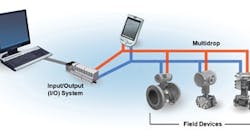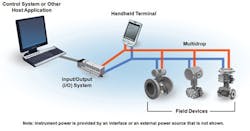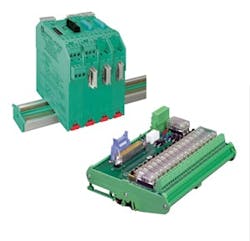There are well over 30 million installed HART devices in the world. Roughly 15% to 20% of them are connected digitally through direct connection to the control system. The rest of the HART population is being used simply as a single PV transmitter or valve positioner over a conventional 4-20m A dc current loop. The HART smart capability of the device is only used for setup and calibration of the instrument. Using HART technology in this way limits its usefulness in the plant to just twice a year.
Automation professionals no longer can afford to do this. There is so much valuable information in HART-enabled devices that the use of that information can seriously affect the profitability of the enterprise. And now, with HART 7 and WirelessHARTTM, there are simple and easy ways to get that information out of the device and into the hands of the engineers, operators and maintenance and operations personnel who need it.
Trapped Inside
The vast majority of HART-enabled devices have only one output connected to the control system—the PV (process variable) that reports on the 4-20 mA loop. Depending on the manufacturer, there is a lot more intelligent information within the device that can be accessed. (See Figure 1.)
Other information items stranded inside the transmitter are device configuration, device calibration, the 32-character device tag, loop check data and much more system and process diagnostic information. Some of this is useful to the process control system, but much of it is even more useful for the quality and asset management systems.
Here are some examples of the really useful data that can be found in various types of field devices and final control elements.
Magnetic FlowMeters
- Flow
- Raw Flow
- Volumetric Flow
- Smoothed Flow
- Positive Total
- Negative Total
- Net Total
- Process and Diagnostic Alarms
Ultrasonic FlowMeters
- Flow
- Sound Velocity
- Positive Total
- Negative Total
- Process and Diagnostic Alarms
Vortex FlowMeters
- Mass Flow
- Volumetric Flow
- Velocity
- Total Flow
- Process Temperature
- Vortex Frequency
- Process and Diagnostic Alarms
Hydrostatic Level Meters
- Level
- Volume
- Pressure
- Differential Pressure
- Sensor Pressure
- Process Temperature
- Sensor Temperature
- Process and Diagnostic Alarms
Pressure Transmitters
- Pressure
- Differential Pressure
- Percent Range
- Electronics Temperature
- Sensor Temperature
- Process and Diagnostic Alarms
pH (and other wet chemistry) Transmitters
- pH
- Process Temperature
- Electrode PerformanceProcess and Diagnostic Alarms
Valve Positioners and Damper Operators
- Stem Position Percentage
- Input
- Supply Pressure
- Set Point
- Deviation from Set Point
- Actuator Pressure
- Positioner Temperature
- Process and Diagnostic Alarms
- Total Strokes
Getting the Data Un-Stranded
So why has this data typically remained stranded? For many years, even though it was available, DCSs and PLC-based control systems were not able to take the data in directly. Companies such as Pepperl+Fuchs and Moore Industries International have made up for this by producing HART interface modules. (See Figure 2).
These interface modules typically have taken the HART data, stripped it off the 4-20mA loop and presented it to the control system in the form of Modbus, Modbus TCP serial digital information or additional 4-20mA input signals.
Many control system manufacturers now have HART-enabled I/O, allowing native HART data directly into the DCS, and most of the major vendors are expected to release this feature for HART 7 devices (backward-compatible to earlier HART Protocol versions) in the next 12 months.
The multi-drop, all-digital network configuration of HART-enabled field devices is also available for this purpose.
But what happens if you have a control system that doesn’t accept HART data or you don’t have room in your marshalling cabinets to install HART Interface Modules? What happens if it just plain costs too much money, and you can’t make the justify the project, even though you know you will save time, save money, and provide better performance to the plant—but you just can’t prove it in advance?
And what happens if some of the measurements you need aren’t from traditional process sensors at all—say from alarm switches on safety showers or gas detectors that would never have been interfaced with the DCS or other control system?
Enter WirelessHARTTM
The HART Communication Foundation realized that there was a need for more than one way to connect data from HART devices to control and operations systems. So as an integral part of the HART 7 release, it created WirelessHARTTM. WirelessHARTTM is the only wireless communication protocol that is designed to work seamlessly and completely integrate with an industrial wired protocol.
So when do you use WirelessHARTTM? WirelessHARTTM is useful for hard-to-reach locations. It is great for doing process efficiency calculations, not just process monitoring and control. You certainly can use WirelessHARTTM sensors for control applications. Control columnist and Emerson Process Management consultant Greg McMillan wrote recently, “With the wireless PID algorithm, a comprehensive battery life management approach, exception reporting and a secure, reliable self-organizing and optimizing network, wireless process control is ready for all but the fastest processes, provided the transmitter resolution settings are right for the application. Use of wired devices will be relegated to processes requiring scan and PID execution times much faster than once per second, such as compressor surge and pressure control."
WirelessHARTTM can allow process operations personnel to place transmitters where they could never afford to place a wired device before. They can now use WirelessHARTTM devices to monitor secondary variables that can help optimize the process but that previously were impossible to measure in a cost-effective way. Maintenance personnel can monitor rotating machinery where it was not feasible without wireless sensors. Environmental monitoring personnel can measure health and safety tools, such as safety showers and gas detectors…even gas detectors carried on the person. Steam traps, water discharge, stack emissions, relief valve fugitive emissions and many other parameters and devices can be monitored in an extremely cost-effective way, using WirelessHARTTM sensors and devices.
This is why it is such a valuable feature of the HART 7 Protocol that the same information and the same programming and the same types of devices are available—wired or wireless.
For those who have wired devices and don’t have the ability to put in HART multiplexers or interface modules because of cost or space constraints, WirelessHARTTM adapters provide a simple, easy and cost-effective way to get the stranded data out of existing HART devices and into the control and information systems of the plant.
Interfacing with Other Systems
The HART data can be converted by industry-standard OPC server technology and imported into any OPC-compliant control system, data historian or database.
In addition, the Wireless Cooperation Team, formed of delegates from the Fieldbus Foundation and the Profibus Technical Organization, has been working for more than a year now to produce an interface specification for a gateway between WirelessHARTTMand FOUNDATION fieldbus communication technologies; an interface specification for a gateway between WirelessHARTTM and Profibus DP and Profinet communication technologies; and a common set of compliance guidelines for incorporation into the respective product registration procedures. This will mean that end users will have the ability to use any of the three most commonly found communication protocols without worrying about compatibility or interoperability issues.
Improve the bottom line
Plant optimization, advanced process control and predictive and prescriptive maintenance programs have been shown for years to contribute directly to the bottom line. Yet it has been expensive, in some cases prohibitively so, to instrument the process well enough to apply those techniques in the plant. HART 7 and WirelessHARTTM have broken that barrier and liberated all the data in the plant.

Leaders relevant to this article:








